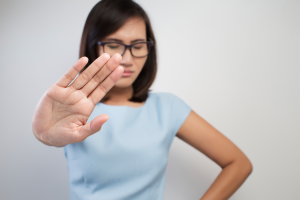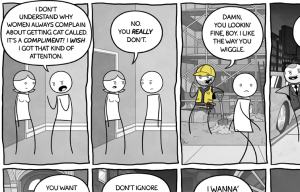
Source: Rewind & Reframe
In a lot of circles, there is a perception that this generation of LGBTQIA+ teens have more support and greater security and face fewer challenges and less hostility than ever before.
In large part, that’s because we now live in a world where queer youth may come out to their peers via social media and then can expect to grow up, and if they want, have a family, and in more and more places, legally marry.
Combine this with the fact that LGBTQIA+ teens have increased access to Gay/Straight Alliances (GSA’s), community programs, Internet support, and positive media representations, and things start to seem pretty hopeful.
That’s a major shift from my experience as a teen in the nineties when not one kid was out in my high school, the fight for marriage equality was in its earliest days, and Bill Clinton’s endorsement of the military’s “Don’t Ask, Don’t Tell” policy actually passed for liberal politics.
Yet, despite today’s advances, we all know that homelessness, suicide, homophobia, and transphobia remain awful realities for too many young people.
In the queer community, and even beyond, these crises get a decent amount of attention. But many LGBTQIA+ teens face different challenges that are closely connected to navigating contemporary expectations and realities which don’t always make it on our radar.
So here are five issues that may not grab headlines, but which can still be pretty arduous for queer teens today.
1. Coming Out Younger
For the past few decades, the average age to come out has been getting younger.
A British study found that generationally, there has been a continuous drop in the age of coming out. For people over 60, the average was 37. For those in their 30s, the average age was 21. But for those between 18 and 24, the average age to come out was 17.
Similarly, American research out of Cornell has found the typical LGBTQIA+ youth now comes out at 16, compared to 21 in the 1970s.
In many ways, coming out earlier is a really positive thing.
For a lot of teens, coming out in high school is a freeing experience that connects them to community, allows them to access support, and takes the stress of hiding off their shoulders.
But there are also risks since coming out can leave a young person vulnerable to harassment and hostility.
A significant number of kids are also coming out well before high school. Again, this can have numerous benefits. But since preteens are even more emotionally and physically susceptible to abuse than are their older peers, the difficulties can intensify the younger someone is.
To complicate things further, some of the worst abuse suffered by LGBTQIA+ teens happens at home, leaving minors nowhere to turn, especially if school is also a hostile environment.
As a government study on LGBTQIA+ youth homelessness reported, “We are seeing a new epidemic…largely because youth are coming out earlier. They are coming out to their families at age 12 or 13 instead of 18 or 20. In some ways, this is a good thing; it means they are getting societal cues that it is [acceptable] to be gay, but they are not old enough to be able to live independently yet, and they face rejection by parents and families and emotional and/or physical abuse at school.”
As this study so clearly demonstrates, LGBTGIA+ youth it can be extremely complicated to navigate the not always compatible realities of modern life.
2. Pressure to Come Out
We never ask hetero or cisgender teens to publicly discuss their sexual orientations or gender identities, yet in a lot of forward-thinking communities, this is expected of LGBTQIA+ teens.
Indeed, in some environments, the idea that a teen just isn’t ready to come out is simply considered old fashioned, uncool, or uptight.
Sometimes queer kids are expected to be ambassadors for their communities. Other times, peers feel thatLGBTQIA+ friends are betraying themselves by not coming out and would just be so much happier if they did. And of course, there are also situations where a partner is sick of hiding a relationship.
As one boy wrote on the LGBT Teens site that I edit:
“I am dating a new guy and we have been friends for five years. He already came out to me, and I came out to him. But now he wants us to come out to everyone together at once and I’m not ready. But his birthday is coming up and he said that what he wants is for everyone to know we are dating.”
Obviously, this kid’s boyfriend has every right not to date someone who isn’t out. But coming out to please a partner is a really complicated move and one that could go south fast.
Whatever the motivation, expecting young people to come out before they are ready, or chastising them for not doing so, is unfair and places too much of a burden on adolescents whether or not they have figured out their identities.
3. Increased Visibility
The days when the closest you could get to queer representation on TV was Three’s Company’s Jack Tripper as a hetero man playing gay for laughs are a thing of the past. Hollywood, too, has moved from only showing only LGBTQIA+ characters as pathetic or predatory to allowing for a little more nuance.
Off screen, we have YA novels featuring non-suicidal queer characters, an openly gay NFL player, respected transgender spokespeople like Laverne Cox, and a few politicians who wear LGBTQIA+ identities openly and attempt to move progressive causes forward.
Yet with increased visibility comes increased detection, and as a result, kids may be outed by peers who in the past may not have noticed a gay classmate.
Emma Mogavero is a bisexual high school junior from New York who works with GLSEN (the Gay Lesbian Straight Education Network) and has witnessed this phenomenon. She says:
“My best friend was brutally bullied in middle school, not because he was gay (he hadn’t figured it out yet), but because he was perceived [to be gay] due to his voice, his mannerisms, the fact that he was into musical theater, etc.
Not only that, but even today as an openly gay teenager who is trying to start a GSA in his Catholic school, he still feels he has to hide certain parts of his personality because he doesn’t want to be seen as that guy.”
Is also important to realize that as queer visibility increases, it isn’t only unwanted outing that can result. So too can backlash.
As Carl Siciliano, founder of the Ali Forney Center, a New York organization serving homeless LGBTQIA+ youth, told Rolling Stone Magazine, “The summer that marriage equality passed in New York, we saw the number of homeless kids looking for shelter go up 40%.”
Often driven by hostile religious beliefs and fired up religious leaders aghast at increasing support for LGBTQIA+ rights, parents may now be hyper-reactive. The results can be everything from abuse at home, to curbs on freedoms, kicking that child out, or forced “conversion” therapy.
4. The Internet
The Internet has provided a lifeline for countless queer youth, connecting them to supportive organizations like GLSEN, The Trevor Project, It Gets Better, Scarleteen, the ACLU, Advocates for Youth, The National Center for Transgender Equality, and PFLAG just to name a few.
But not all kids have the same online access. Plenty of parents and schools monitor kids’ Internet use and install filters and trackers.
What people don’t always realize is that many of these programs don’t just block out porn. Almost all of the most commonly used software includes a special category to block websites that have information about LGBTQIA+ issues and organizations, even though the websites are not sexually explicit in any way!
Then there is the issue of search terms. The wrong search terms can send teens to some pretty awful places.
If you are a kid who has not had a lot of exposure to the queer community, you might type in the language you have heard at home, in your church, or from your abstinence-only education program. The result is that you may come up with things like: “Is homosexuality a sin?” or “How do I overcome my lesbianism?” or “What should I do about unwanted same-sex attraction?”
Indeed, when I typed in “What should I do about unwanted same-sex attraction?” the first result I got was for a site called Same Sex Attraction, which greeted me with this message: “If you don’t want to be gay, you don’t have to be. There is a way to overcome your same-gender (gay or lesbian) feelings and homosexual behavior. If you want to make changes in your life, you can.”
The rest of the results on the first search page came from religious Christian groups that treat the idea of conversion therapy as real science and which spew horrifying lies about what it means to be gay.
On the other hand, even a slight change of language elicited really different results. When I typed in “Is being gay a choice?” I got two YouTube videos telling me it wasn’t, and then articles from the Huffington Post, Upworthy, and the New Republic confirming this assertion.
5. Life at School
Though youth often drive social change, school – the institution most often central in young peoples’ lives – often lags behind when it comes to providing a safe and supportive environment for LGBTQIA+ students.
Though we now have GSA’s, Safe Spaces, and the occasional queer or trans prom king or queen, there are far too many schools where LGBTQIA+ teens still face discrimination and harassment on a daily basis.
A 2013 GLSEN survey found that schools nationwide remain hostile environments for a troubling number of queer students. According to the survey,
- 74% percent were verbally harassed in the past year because of their sexual orientation, 55% because of their gender expression
- 30% missed at least one day of school in the past month as a result of feeling unsafe or uncomfortable
- 36% were physically harassed because of their sexual orientation and 23% because of their gender expression
- 17% were physically assaulted because of their sexual orientation and 11% because of their gender expression
- 65% heard homophobic remarks frequently or often
- 33% heard negative remarks specifically about transgender people, like “tr*nny” or “he/she,” frequently or often.
And it isn’t only peer-on-peer harassment that’s a problem. For Casey Hoke, a gay transgender high school senior who also works with GLSEN, one of the most frustrating aspects of school has been dealing with teachers. As he says:
“[Teachers weren’t using accurate] pronouns before I legally changed my gender marker, there was confusion and prejudice against me beginning to using male facilities. Some were unaware of how to address LGBT-specific bullying and slur usage, and ‘outed’ me in class discussions.”
His recommendation? “Teacher training is crucial should be implemented for every district so that teens can feel more comfortable in their places of learning.”
What We Can Do
The good news is that adult allies can help LGBTQIA+ youth address these issues. Here are a few ways how:
1. If you work with youth, create a welcoming environment both for kids ready to come out and for those who are not. GSAs are one good way to do this since they give kids of any identity, or at any stage of identifying, a place to address LGBTQIA+ issues.
2. Don’t give religiously motivated hate-speech a pass. This seems obvious, but sometimes religious intolerance is seen as more acceptable than plain old secular intolerance.
3. If you identify as queer, don’t tell kids how much easier they have it today than when you were a kid. This diminishes and invalidates their struggles.
4. Educate teens about their legal rights. Let them know that the ACLU accepts reports about harassment based on sexual orientation and gender identity, as well as about public schools that use anti-gay Internet filters, allow hostile environments, or prevent teens from bringing same gender dates to school events where opposite gender dates are allowed.
5. If you have a website that you think would help LGBTQIA+ teens, consider broadening your language to reach a wider range of kids.
Queer Teens Can Still Be Really Isolated
Today’s world offers queer teens opportunities impossible to imagine even a decade ago. But there are still plenty of teens for whom those opportunities are not at all on the horizon.
As this girl recently posted on my LGBT teens site:
“I am lesbian, and I live in East Texas. East Texas is a small and ‘normal’ area. I hardly have any friends here at all. I am homeschooled, and 90% of the children in my neighborhood know that I am a lesbian and despise me for it. They treat me as if I am a disease.”
This post, and the countless others like it, are important reminders that while we have come a long way, we still have a long way to go.
But with a rising generation of young, empowered queer activists on the scene, I am pretty sure that an ever more positive future is on the horizon.
[do_widget id=”text-101″]
Ellen Kate is a Contributing Writer at Everyday Feminism. Originally from Canada, she is a health educator (and mom) based in New York City, where she teaches high school and college classes, and runs About.com’s LGBT Teens website. Find more of her writing here and follow her on Twitter @ellenkatef.
Search our 3000+ articles!
Read our articles about:
Our online racial justice training
Used by hundreds of universities, non-profits, and businesses.
Click to learn more




















